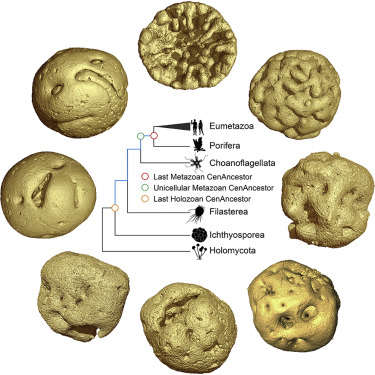Animal-like Embryos Evolved Before the First Animals Appear in the Fossil Record
Catching up with our reading, examining university press releases and having a little time to review some scientific literature enabled team members at Everything Dinosaur to get to grips with this research. A new paper has been published in the journal “Current Biology” that sheds light on how the Animalia evolved. Researchers led by scientists from the University of Bristol and Nanjing Institute of Geology and Palaeontology (Nanjing, China), have discovered that animal-like embryos evolved long before the first animals appear in the fossil record.
The study centred around a multicellular organism found in 609-million-year-old-rocks in Guizhou Province. The organism is called Caveasphaera and it blurs the definition as to what is and what is not an animal. However, analysis of tiny embryonic fossils suggests that as Caveasphaera developed it went from a single-cell stage to a multi-cellular stage and that it developed distinct, specialist cells and tissues.
Remarkable Fossils Reveal Ancient Organism May Have Set the Blueprint for Animal Body Plans
Picture credit: Philip Donoghue and Zongjun Yin
Fossil Record Reveals Animals Evolved from Single-celled Ancestors
Animals evolved from single-celled ancestors, subsequently, the Animalia diversified into thirty or forty body plans. How and when animal ancestors made this evolutionary transition from a microbial state into complex multicellular creatures has been discussed and debated for many years. The researchers, using sophisticated X-ray computer tomography, analysed tiny fossils from southern China and identified that a key step in this major step in the story of life on our planet occurred long before complex animals appear in the fossil record, in the fossilised embryos that resemble multicellular stages in the life cycle of single-celled relatives of animals.
X-ray Microscopy – Fossils on the Cellular Level
Analysis of the Ediacaran fossils preserved in the strata, revealed that the tiny 0.5 mm in diameter Caveasphaera material had been preserved all the way down to their component cells.
Co-author of the study paper, Kelly Vargas (Bristol University), commented:
“X-Ray tomographic microscopy works like a medical CT scanner, but allows us to see features that are less than a thousandth of a millimetre in size. We were able to sort the fossils into growth stages, reconstructing the embryology of Caveasphaera.”
Fellow co-author Zongjun Yin, (Nanjing Institute of Geology and Palaeontology), added:
“Our results show that Caveasphaera sorted its cells during embryo development, in just the same way as living animals, including humans, but we have no evidence that these embryos developed into more complex organisms.”
Scanning Electron Microscope Image of Caveasphaera Showing Cell Division

Picture credit: Philip Donoghue and Zongjun Yin
A Life Cycle that Mirrors the Development of Animals
The researchers concluded that Caveasphaera had a life cycle very close to the life cycle of animals which alternate between single-celled and multicellular stages, however, Caveasphaera goes one step further, reorganising those cells during embryology. This is the earliest fossil evidence found to date that shows such development and the setting up of more complex distinct tissue layers and organs.
Whether the enigmatic, Caveasphaera is a member of the Animalia remains open to debate. It resembles the embryos of some starfish and corals but no adult forms are known as they may not have been easily fossilised.
Professor Philip Donoghue from the University of Bristol’s School of Earth Sciences, stated:
“Caveasphaera shows features that look both like microbial relatives of animals and early embryo stages of primitive animals. We’re still searching for more fossils that may help us to decide. Either way, fossils of Caveasphaera tell us that animal-like embryonic development evolved long before the oldest definitive animals appear in the fossil record.”
Sequential Development of Caveasphaera Mirrors the Development Seen in the Animalia

Picture credit: Philip Donoghue and Zongjun Yin
Everything Dinosaur acknowledges the assistance of a press release from Bristol University in the compilation of this article.
The scientific paper: “The early Ediacaran Caveasphaera foreshadows the evolutionary origin of animal-like embryology” by Z. Yin, K. Vargas, J. Cunningham, S. Bengtson, M. Zhu, F. Marone and P. Donoghue published in Current Biology.
The Everything Dinosaur website: Everything Dinosaur.







Leave A Comment